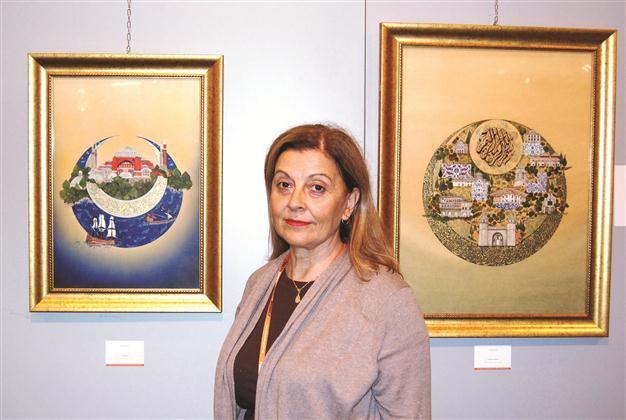Turkish artists at eighth Int’l Florence Biennale
FLORANCE - Anatolia News Agency

Artist Esin Kazazoğlu uses the Ottoman Çintemani motif in her work at the Florence Biennale.
The eighth edition of the International Biennale of Contemporary Art, organized annually in the Italian city of Florence since 1997, opened Dec. 3. This year, over 600 artists from 70 countries are participating, with Turkey represented by more than 35 artists.Derviş Ergün, chairman of Muğla University Bodrum fine arts department, said his works were often a critique of postmodernism. “As the whole world sees postmodernism as savory, freedom presented by postmodernism is being consumed so freely the world has lost its ideology.”
Ergün said he had visited lots of countries in the world and seen ignorance rising under the name of postmodernism almost everywhere. Speaking about his submitted work showcased at the biennale, Ergün said, “This piece is a bell but it does not make any sound. Societies have no more sound. Everything is passive. People have been absorbed into a vicarious life. This is true all around the world, not only in Turkey. Art is a witness to all these things and my work is a reaction to this fact. That is why the bell is silent even though it is a tool of communication.”
Women without identity
A Turkish artist from İzmir, İnci Tarakçıoğlu, explained her theme as “women without identity.” “I have been working on women for nearly three years. I show them as nude but there are no expressions on their faces. It hurts me women are losers in society and they are constricted by pressure in Turkey,” she said.
Her work is a kind of rebellion or objection, she explained. “I want women to know their own value, to realize the holy mission that God gave them. They should realize it depends on them to provide world peace and to raise their sons considering this.”
Other artists representing Turkey at the event included painter Aydın Arkun, who said his series “Politician Red” symbolized the fact politicians were “staining the world with blood,” and Mediha Tekin, who used Eve as the focus of the piece she submitted to the biennale. Eve is an important character in all religions, she explained. Titled “the apple garden of Eve,” her work, which comprises many different “information cubes,” aims to explore the idea that information all around the world is stored somewhere. “People know everything, what is good and what is bad. They can live their lives in a very appropriate way, but they do not. They do not want to do the right things,” she said.
The biennale also presents miniatures, unique to Turkish art, and works with Çintemani motif, which was mostly used during the Ottoman era.
Miniature artist Esin Kazazoğlu said she liked using Çintemani motifs in her work. “This is a motif brought to the Ottomans from the Middle East. It is formed by three interconnected circles. I applied this motif in miniature and put the Hagia Sophia in the center. Since Istanbul is surrounded by seas, I also included the sea,” she said.
Another miniature artist Ruhsal Özer said the painting she had created for the biennale depicting Istanbul and Florence together had drawn great interest. “The architect of Florence Cathedral is Brunelleschi, a Renaissance architect. Our biggest architect is Sinan, the architect of Süleymaniye. My painting tells of the two cities, the story of two architects.”
Artist Ali Önder joins the biennale with digital painting and fractal works, upon which he has worked for nearly 13 years. He complained very few people were interested in this type of art in Turkey, thinking fractal art resembled Photoshop. “It is actually formed by high-resolution digital paintings produced with mathematic formulas,” he said.
The biennial will conclude with an award ceremony Dec. 11.
















